switch FIAT QUBO 2009 1.G User Guide
[x] Cancel search | Manufacturer: FIAT, Model Year: 2009, Model line: QUBO, Model: FIAT QUBO 2009 1.GPages: 202, PDF Size: 4.78 MB
Page 60 of 202
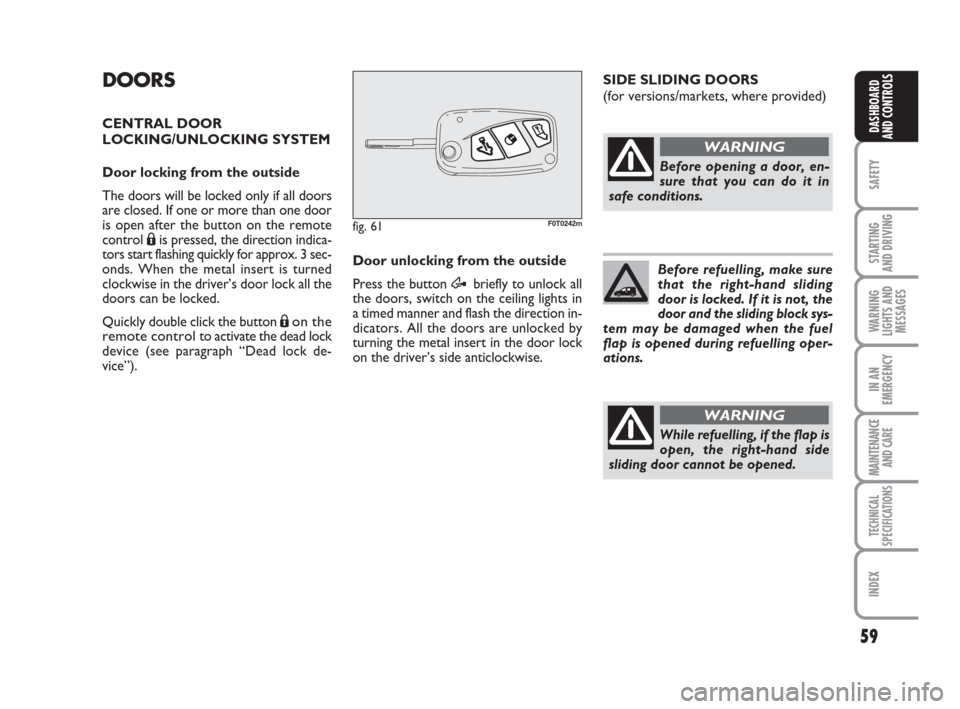
59
SAFETY
STARTING
AND DRIVING
WARNING
LIGHTS AND
MESSAGES
IN AN
EMERGENCY
MAINTENANCE
AND CARE
TECHNICAL
SPECIFICATIONS
INDEX
DASHBOARD
AND CONTROLS
DOORS
CENTRAL DOOR
LOCKING/UNLOCKING SYSTEM
Door locking from the outside
The doors will be locked only if all doors
are closed. If one or more than one door
is open after the button on the remote
control Áis pressed, the direction indica-
tors start flashing quickly for approx. 3 sec-
onds. When the metal insert is turned
clockwise in the driver’s door lock all the
doors can be locked.
Quickly double click the button Á
on the
remote control to activate the dead lock
device (see paragraph “Dead lock de-
vice”). Door unlocking from the outside
Press the button Æbriefly to unlock all
the doors, switch on the ceiling lights in
a timed manner and flash the direction in-
dicators. All the doors are unlocked by
turning the metal insert in the door lock
on the driver’s side anticlockwise.
fig. 61F0T0242m
While refuelling, if the flap is
open, the right-hand side
sliding door cannot be opened.
WARNING
SIDE SLIDING DOORS
(for versions/markets, where provided)
Before opening a door, en-
sure that you can do it in
safe conditions.
WARNING
Before refuelling, make sure
that the right-hand sliding
door is locked. If it is not, the
door and the sliding block sys-
tem may be damaged when the fuel
flap is opened during refuelling oper-
ations.
036-082 QUBO GB 1ed:_ 3-12-2009 11:55 Pagina 59
Page 64 of 202

63
SAFETY
STARTING
AND DRIVING
WARNING
LIGHTS AND
MESSAGES
IN AN
EMERGENCY
MAINTENANCE
AND CARE
TECHNICAL
SPECIFICATIONS
INDEX
DASHBOARD
AND CONTROLS
WINDOW WINDERS
FRONT POWER WINDOWS
(for versions/markets, where provided)
Buttons fig. 70have been provided on the
driver’s door panel to control the follow-
ing functions with the ignition turned to
MAR:
A:opening/closing of left-hand window;
B:opening/closing of right-hand window.
Press buttons Aor Bto open/close the
desired window.
When one of these buttons is pressed
shortly, the window “jogs”; when pressed
for long, continuous automatic window
lifting or lowering is engaged. The window
stops in the required position when but-
ton Aor Bis pressed again.
The power windows are fitted with a safe-
ty system (for versions/markets, where
provided) that detects the presence of an
obstacle during window closing and cuts
in by stopping and reversing the window
stroke.IMPORTANT If the anti-crush function is
enabled for 5 times within 1 minute, the
system automatically switches to “recov-
ery” mode (self-protection). This condi-
tion is highlighted by upward jogging of the
window while closing.
In this case, it is necessary to carry out the
system restore procedure as follows:
❒open the windows;
or
❒turn the ignition key to STOPand then
to MAR.
If no malfunction is present, the window
returns to its normal operation automat-
ically.
IMPORTANT With ignition key in STOP
position or removed, the power windows
remain activated for about 2 minutes and
are deactivated immediately as soon as a
door is opened.
fig. 70F0T0044m
Incorrect use of the power
windows may be dangerous.
Before operation, always check that
no passenger is exposed to the risk of
being injured directly by the moving
window or by objects getting caught
in or dragged by the window.
WARNING
When leaving the vehicle, al-
ways remove the ignition key
to avoid the risk of injury due to ac-
cidental operation of the power win-
dows.
WARNING
FRONT MANUAL
WINDOW WINDERS
Some versions feature manual window
winders.
To open/close, operate the handle.
036-082 QUBO GB 1ed:_ 3-12-2009 11:55 Pagina 63
Page 73 of 202
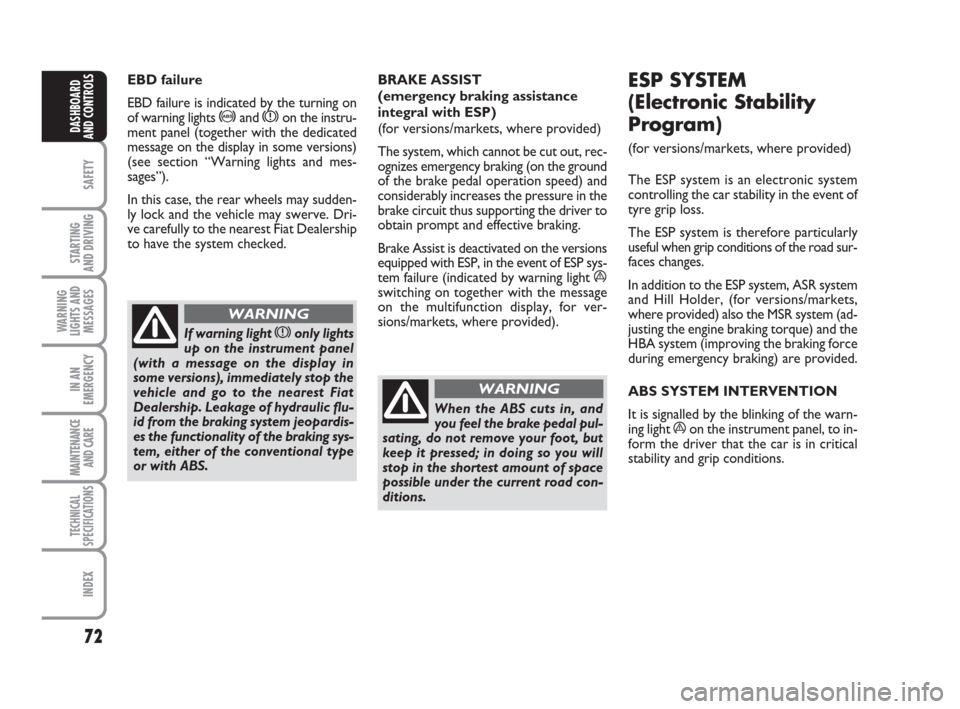
If warning light xonly lights
up on the instrument panel
(with a message on the display in
some versions), immediately stop the
vehicle and go to the nearest Fiat
Dealership. Leakage of hydraulic flu-
id from the braking system jeopardis-
es the functionality of the braking sys-
tem, either of the conventional type
or with ABS.
WARNING
72
SAFETY
STARTING
AND DRIVING
WARNING
LIGHTS AND
MESSAGES
IN AN
EMERGENCY
MAINTENANCE
AND CARE
TECHNICAL
SPECIFICATIONS
INDEX
DASHBOARD
AND CONTROLS
EBD failure
EBD failure is indicated by the turning on
of warning lights
>and xon the instru-
ment panel (together with the dedicated
message on the display in some versions)
(see section “Warning lights and mes-
sages”).
In this case, the rear wheels may sudden-
ly lock and the vehicle may swerve. Dri-
ve carefully to the nearest Fiat Dealership
to have the system checked.BRAKE ASSIST
(emergency braking assistance
integral with ESP)
(for versions/markets, where provided)
The system, which cannot be cut out, rec-
ognizes emergency braking (on the ground
of the brake pedal operation speed) and
considerably increases the pressure in the
brake circuit thus supporting the driver to
obtain prompt and effective braking.
Brake Assist is deactivated on the versions
equipped with ESP, in the event of ESP sys-
tem failure (indicated by warning light
áswitching on together with the message
on the multifunction display, for ver-
sions/markets, where provided).
ESP SYSTEM
(Electronic Stability
Program)
(for versions/markets, where provided)
The ESP system is an electronic system
controlling the car stability in the event of
tyre grip loss.
The ESP system is therefore particularly
useful when grip conditions of the road sur-
faces changes.
In addition to the ESP system, ASR system
and Hill Holder, (for versions/markets,
where provided) also the MSR system (ad-
justing the engine braking torque) and the
HBA system (improving the braking force
during emergency braking) are provided.
ABS SYSTEM INTERVENTION
It is signalled by the blinking of the warn-
ing light
áon the instrument panel, to in-
form the driver that the car is in critical
stability and grip conditions.
When the ABS cuts in, and
you feel the brake pedal pul-
sating, do not remove your foot, but
keep it pressed; in doing so you will
stop in the shortest amount of space
possible under the current road con-
ditions.
WARNING
036-082 QUBO GB 1ed:_ 3-12-2009 11:55 Pagina 72
Page 75 of 202

74
SAFETY
STARTING
AND DRIVING
WARNING
LIGHTS AND
MESSAGES
IN AN
EMERGENCY
MAINTENANCE
AND CARE
TECHNICAL
SPECIFICATIONS
INDEX
DASHBOARD
AND CONTROLS
MSR system (engine braking
torque control)
It is an integral part of the ASR system that
in case of sudden gear shifting, cuts in pro-
viding torque to the engine thus prevent-
ing excessive driving wheel drive that, spe-
cially in poor grip conditions, can lead to
loss of stability.
Switching the systemon/off
The ASR system switches on automatically
each time the engine is started.
When travelling, the ASR can be switched
off and on again pressing button A - fig. 93
set on the dashboard.When the ASR is switched off this is
shown by the lighting up of the led on the
button and by relevant message on the
multifunction display, for versions/mar-
kets, where provided.
If the ASR is switched off when travelling,
it will turn on again automatically the next
time the engine is started.
When travelling on snowy roads with
snow chains, it may be helpful to turn the
ASR off: in fact, in these conditions, slip-
ping of the driving wheels when moving off
makes it possible to obtain better drive.
For correct operation of the
ESP and ASR systems, the
tyres must absolutely be of the same
brand and type on all wheels, in per-
fect conditions and, above all, of
type, brand and size specified.
WARNING
fig. 93F0M0317m
ASR SYSTEM (Antislip Regulator)
The ASR function controls car drive and
cuts in automatically every time one or
both driving wheels slip.
According to slipping conditions, two dif-
ferent control systems are activated:
❒if slipping involves both driving wheels,
the ASR function intervenes reducing
the power transmitted by the engine;
❒if the slipping involves only one driving
wheel, the ASR system cuts in auto-
matically braking the wheel that is slip-
ping.
The action of the ASR is particularly help-
ful in the following circumstances:
❒ slipping of the inner wheel due to the
effect of dynamic load changes or ex-
cessive acceleration;
❒ too much power transmitted to the
wheels also in relation to the conditions
of the road surface;
❒ acceleration on slippery, snowy or
frozen surfaces;
❒ in the case of loss of grip on a wet sur-
face (aquaplaning).
036-082 QUBO GB 1ed:_ 3-12-2009 11:55 Pagina 74
Page 77 of 202
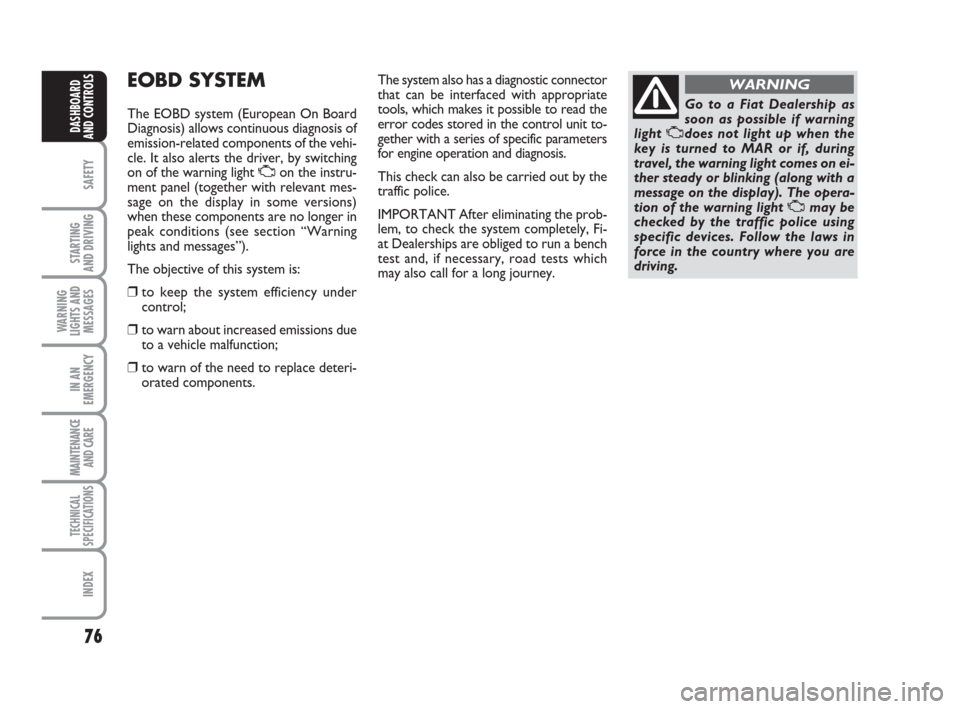
76
SAFETY
STARTING
AND DRIVING
WARNING
LIGHTS AND
MESSAGES
IN AN
EMERGENCY
MAINTENANCE
AND CARE
TECHNICAL
SPECIFICATIONS
INDEX
DASHBOARD
AND CONTROLS
EOBD SYSTEM
The EOBD system (European On Board
Diagnosis) allows continuous diagnosis of
emission-related components of the vehi-
cle. It also alerts the driver, by switching
on of the warning light Uon the instru-
ment panel (together with relevant mes-
sage on the display in some versions)
when these components are no longer in
peak conditions (see section “Warning
lights and messages”).
The objective of this system is:
❒to keep the system efficiency under
control;
❒to warn about increased emissions due
to a vehicle malfunction;
❒to warn of the need to replace deteri-
orated components.The system also has a diagnostic connector
that can be interfaced with appropriate
tools, which makes it possible to read the
error codes stored in the control unit to-
gether with a series of specific parameters
for engine operation and diagnosis.
This check can also be carried out by the
traffic police.
IMPORTANT After eliminating the prob-
lem, to check the system completely, Fi-
at Dealerships are obliged to run a bench
test and, if necessary, road tests which
may also call for a long journey.Go to a Fiat Dealership as
soon as possible if warning
light Udoes not light up when the
key is turned to MAR or if, during
travel, the warning light comes on ei-
ther steady or blinking (along with a
message on the display). The opera-
tion of the warning light Umay be
checked by the traffic police using
specific devices. Follow the laws in
force in the country where you are
driving.
WARNING
036-082 QUBO GB 1ed:_ 3-12-2009 11:55 Pagina 76
Page 82 of 202

81
SAFETY
STARTING
AND DRIVING
WARNING
LIGHTS AND
MESSAGES
IN AN
EMERGENCY
MAINTENANCE
AND CARE
TECHNICAL
SPECIFICATIONS
INDEX
DASHBOARD
AND CONTROLS
DIESEL ENGINES
Operation at low temperatures
If the outside temperature is very low, the
diesel thickens due to the formation of
paraffin clots with consequent anomalous
operation of the fuel supply system.
In order to avoid these problems, different
types of diesel are distributed according to
the season: summer type, winter type and
arctic type (cold, mountain areas). If refu-
elling with diesel fuel whose features are not
suitable to the temperature of use, it is ad-
visable to mix TUTELA DIESEL ART addi-
tive in the proportions shown on the con-
tainer with the fuel. Pour the additive in-
to the tank before the fuel.
When using or parking the vehicle for a
long time in the mountains or cold areas,
it is advisable to refuel using locally avail-
able fuel.
In this case, it is also advisable to keep the
tank over 50% full.For diesel engines, use diesel
fuel for motor vehicles com-
pliant with EN590 European
specifications only. The use of
other products or mixtures may dam-
age the engine beyond repair and con-
sequently cause lapse of warranty in
relation to the damage caused. If you
accidentally introduce other types of
fuel in the tank, do not start the engine
and empty the tank. If the engine has
run also for a very short time, you will
need to have the entire fuel feed sys-
tem emptied in addition to the tank.
REFUELLING CAPACITY
To fill the tank completely, top-up twice
after the pump switches off. Further top-
ups could cause faults in the fuel feeding
system.
fig. 97
C
A
F0T0068m
FUEL TANK PLUG fig. 97
Opening
1) Open the flap A - fig. 97pulling it out-
wards, keep the cap Bstill, insert the ig-
nition key in the lock and turn it anti-
clockwise.
2) Turn the cap anti-clockwise and extract
it. The cap has a device Cretaining it to
the flap so it cannot be lost. When refill-
ing, attach the cap to the flap, as illustrat-
ed.
Closing
1) Fit the cap (complete with key) and turn
it clockwise until it clicks once or more.
2) Turn the key clockwise and extract it,
then close the flap.
036-082 QUBO GB 1ed:_ 3-12-2009 11:55 Pagina 81
Page 103 of 202
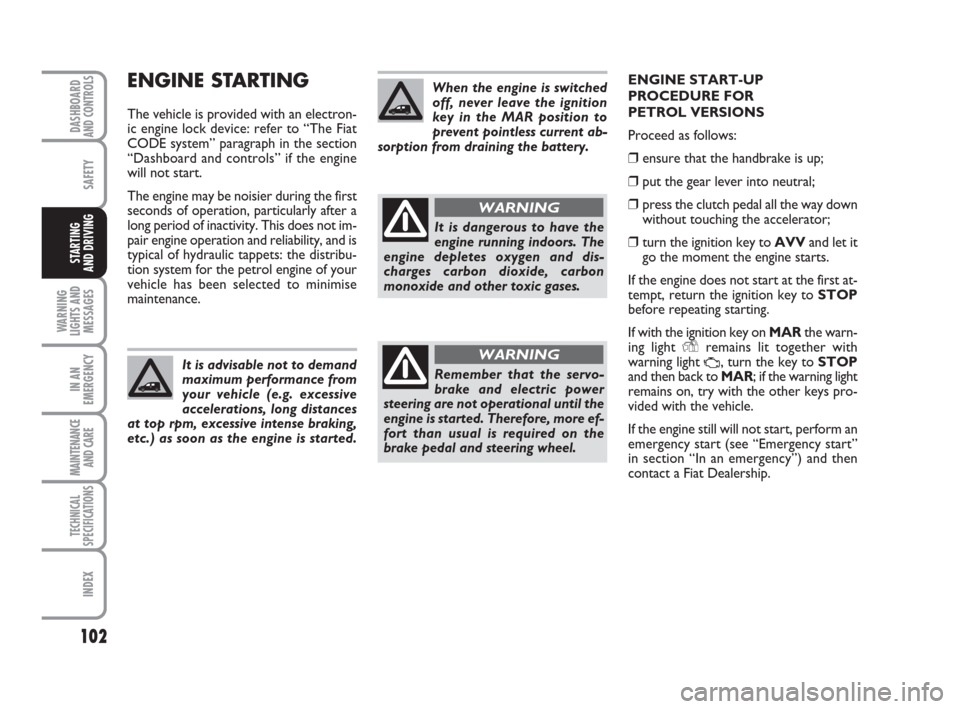
102
SAFETY
WARNING
LIGHTS AND
MESSAGES
IN AN
EMERGENCY
MAINTENANCE
AND CARE
TECHNICAL
SPECIFICATIONS
INDEX
DASHBOARDAND CONTROLS
STARTING
AND DRIVING
ENGINE STARTING
The vehicle is provided with an electron-
ic engine lock device: refer to “The Fiat
CODE system” paragraph in the section
“Dashboard and controls” if the engine
will not start.
The engine may be noisier during the first
seconds of operation, particularly after a
long period of inactivity. This does not im-
pair engine operation and reliability, and is
typical of hydraulic tappets: the distribu-
tion system for the petrol engine of your
vehicle has been selected to minimise
maintenance.ENGINE START-UP
PROCEDURE FOR
PETROL VERSIONS
Proceed as follows:
❒ensure that the handbrake is up;
❒put the gear lever into neutral;
❒press the clutch pedal all the way down
without touching the accelerator;
❒turn the ignition key to AVVand let it
go the moment the engine starts.
If the engine does not start at the first at-
tempt, return the ignition key to STOP
before repeating starting.
If with the ignition key on MARthe warn-
ing light Yremains lit together with
warning light
U, turn the key to STOP
and then back to MAR; if the warning light
remains on, try with the other keys pro-
vided with the vehicle.
If the engine still will not start, perform an
emergency start (see “Emergency start”
in section “In an emergency”) and then
contact a Fiat Dealership. It is advisable not to demand
maximum performance from
your vehicle (e.g. excessive
accelerations, long distances
at top rpm, excessive intense braking,
etc.) as soon as the engine is started.
When the engine is switched
off, never leave the ignition
key in the MAR position to
prevent pointless current ab-
sorption from draining the battery.
Remember that the servo-
brake and electric power
steering are not operational until the
engine is started. Therefore, more ef-
fort than usual is required on the
brake pedal and steering wheel.
WARNING
It is dangerous to have the
engine running indoors. The
engine depletes oxygen and dis-
charges carbon dioxide, carbon
monoxide and other toxic gases.
WARNING
101-108 QUBO GB 1ed:101-110 Fiorino GB 1ed 2-12-2009 9:22 Pagina 102
Page 107 of 202

106
SAFETY
WARNING
LIGHTS AND
MESSAGES
IN AN
EMERGENCY
MAINTENANCE
AND CARE
TECHNICAL
SPECIFICATIONS
INDEX
DASHBOARDAND CONTROLS
STARTING
AND DRIVING
Roof rack/ski rack
Remove the roof rack or the ski rack from
the roof after use. These accessories de-
crease aerodynamic penetration of the ve-
hicle and have a negative effect on fuel
consumption. It is better to use a trailer
to transport particularly bulky objects.
Electric devices
Use electric devices only for the amount
of time needed. The rear heated window,
additional headlights, windscreen wipers
and heater fan need a considerable
amount of energy, therefore increasing fu-
el consumption (up to +25% in the urban
cycle).
Climate control
The climate control system leads to high-
er fuel consumption (up to +20% on av-
erage): use air vents only when the ex-
ternal temperature allows it.
Spoilers
The use of non-certified spoilers may ad-
versely affect air drag and fuel consump-
tion levels.DRIVING STYLE
Starting
Do not warm the engine up with the ve-
hicle running at min. or max. rpm: the en-
gine warms up very slowly in these con-
ditions, increasing consumption and emis-
sions. It is advisable to start off immedi-
ately and slowly keeping the engine speed
down: the engine will warm up much
faster this way.
Unnecessary manoeuvres
Avoid revving up when starting at traffic
lights or before stopping the engine. The
latter manoeuvre, like doubling the clutch,
is unnecessary and causes increased fuel
consumption and pollution.
Gear selection
Use a higher gear as soon as traffic and road
conditions allow. Using a low gear for faster
acceleration will increase consumption.
In the same way improper use of a high gear
increases fuel consumption, emissions and
engine wear.
Top speed
Fuel consumption considerably increases as
speed increases. Keep your speed as uni-
form as possible, avoiding unnecessary
braking and acceleration which cause ex-
cessive fuel consumption and increase emis-
sions.Acceleration
Sudden acceleration has a very negative
effect on consumptions and emissions: ac-
celerate gradually.
CONDITIONS OF USE
Cold starting
Short distances and frequent cold start-
ups will prevent the engine from reach-
ing optimal running temperature.
Consequently, both consumption (from
+15 to +30% on urban cycle ) and emis-
sions will increase.
Traffic and road conditions
Quite high consumption is caused by
heavy traffic, for instance when travelling
in a queue with frequent use of low gears
or in cities with many traffic lights. Moun-
tain and rough roads also have a negative
effect on consumption.
Traffic hold-ups
During prolonged hold-ups (e.g. level cross-
ings) the engine should be switched off.
101-108 QUBO GB 1ed:101-110 Fiorino GB 1ed 2-12-2009 9:22 Pagina 106
Page 113 of 202
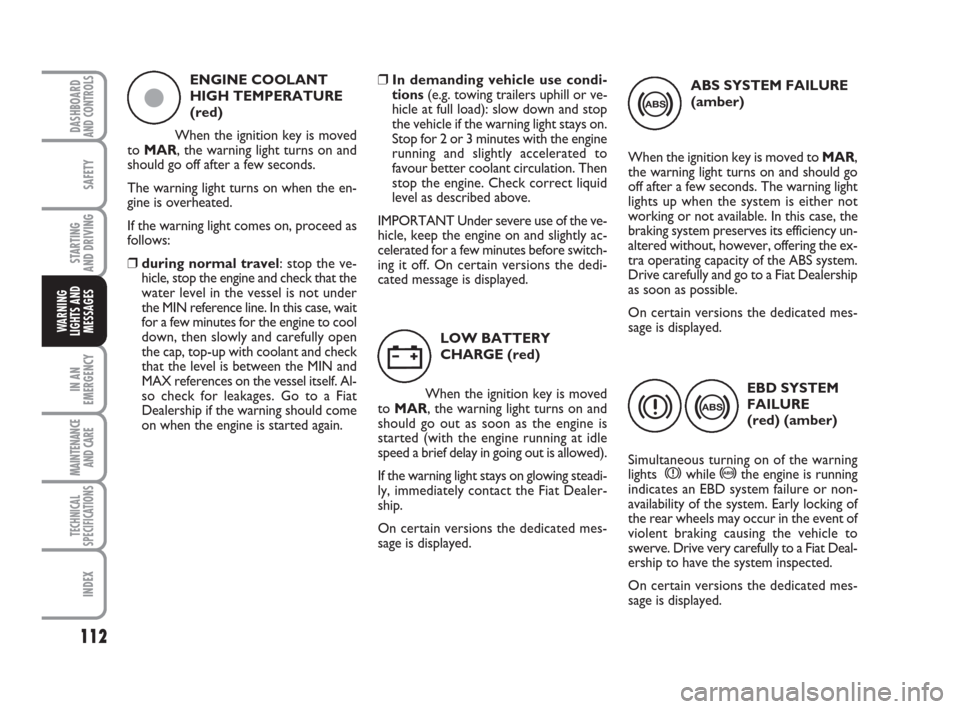
112
SAFETY
IN AN
EMERGENCY
MAINTENANCE
AND CARE
TECHNICAL
SPECIFICATIONS
INDEX
DASHBOARDAND CONTROLS
STARTING
AND DRIVING
WARNING
LIGHTS AND
MESSAGES
ABS SYSTEM FAILURE
(amber)
When the ignition key is moved to MAR,
the warning light turns on and should go
off after a few seconds. The warning light
lights up when the system is either not
working or not available. In this case, the
braking system preserves its efficiency un-
altered without, however, offering the ex-
tra operating capacity of the ABS system.
Drive carefully and go to a Fiat Dealership
as soon as possible.
On certain versions the dedicated mes-
sage is displayed.
EBD SYSTEM
FAILURE
(red) (amber)
Simultaneous turning on of the warning
lights
xwhile >the engine is running
indicates an EBD system failure or non-
availability of the system. Early locking of
the rear wheels may occur in the event of
violent braking causing the vehicle to
swerve. Drive very carefully to a Fiat Deal-
ership to have the system inspected.
On certain versions the dedicated mes-
sage is displayed. ENGINE COOLANT
HIGH TEMPERATURE
(red)
When the ignition key is moved
to MAR, the warning light turns on and
should go off after a few seconds.
The warning light turns on when the en-
gine is overheated.
If the warning light comes on, proceed as
follows:
❒during normal travel: stop the ve-
hicle, stop the engine and check that the
water level in the vessel is not under
the MIN reference line. In this case, wait
for a few minutes for the engine to cool
down, then slowly and carefully open
the cap, top-up with coolant and check
that the level is between the MIN and
MAX references on the vessel itself. Al-
so check for leakages. Go to a Fiat
Dealership if the warning should come
on when the engine is started again.❒In demanding vehicle use condi-
tions (e.g. towing trailers uphill or ve-
hicle at full load): slow down and stop
the vehicle if the warning light stays on.
Stop for 2 or 3 minutes with the engine
running and slightly accelerated to
favour better coolant circulation. Then
stop the engine. Check correct liquid
level as described above.
IMPORTANT Under severe use of the ve-
hicle, keep the engine on and slightly ac-
celerated for a few minutes before switch-
ing it off. On certain versions the dedi-
cated message is displayed.
LOW BATTERY
CHARGE (red)
When the ignition key is moved
to MAR, the warning light turns on and
should go out as soon as the engine is
started (with the engine running at idle
speed a brief delay in going out is allowed).
If the warning light stays on glowing steadi-
ly, immediately contact the Fiat Dealer-
ship.
On certain versions the dedicated mes-
sage is displayed.
ç
w
>
x>
109-118 QUBO GB 1ed:- 3-12-2009 11:59 Pagina 112
Page 114 of 202
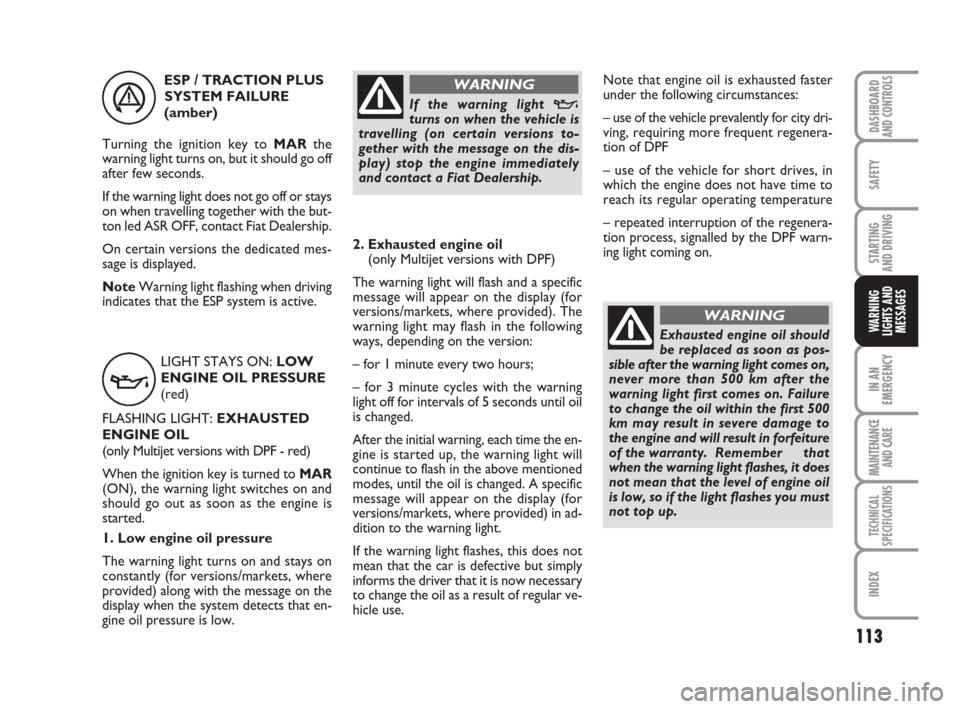
113
SAFETY
IN AN
EMERGENCY
MAINTENANCE
AND CARE
TECHNICAL
SPECIFICATIONS
INDEX
DASHBOARDAND CONTROLS
STARTING
AND DRIVING
WARNING
LIGHTS AND
MESSAGES
v
LIGHT STAYS ON: LOW
ENGINE OIL PRESSURE
(red)
FLASHING LIGHT: EXHAUSTED
ENGINE OIL
(only Multijet versions with DPF - red)
When the ignition key is turned to MAR
(ON), the warning light switches on and
should go out as soon as the engine is
started.
1. Low engine oil pressure
The warning light turns on and stays on
constantly (for versions/markets, where
provided) along with the message on the
display when the system detects that en-
gine oil pressure is low.ESP / TRACTION PLUS
SYSTEM FAILURE
(amber)
Turning the ignition key to MARthe
warning light turns on, but it should go off
after few seconds.
If the warning light does not go off or stays
on when travelling together with the but-
ton led ASR OFF, contact Fiat Dealership.
On certain versions the dedicated mes-
sage is displayed.
NoteWarning light flashing when driving
indicates that the ESP system is active.
áIf the warning light vturns on when the vehicle is
travelling (on certain versions to-
gether with the message on the dis-
play) stop the engine immediately
and contact a Fiat Dealership.
WARNING
2. Exhausted engine oil
(only Multijet versions with DPF)
The warning light will flash and a specific
message will appear on the display (for
versions/markets, where provided). The
warning light may flash in the following
ways, depending on the version:
– for 1 minute every two hours;
– for 3 minute cycles with the warning
light off for intervals of 5 seconds until oil
is changed.
After the initial warning, each time the en-
gine is started up, the warning light will
continue to flash in the above mentioned
modes, until the oil is changed. A specific
message will appear on the display (for
versions/markets, where provided) in ad-
dition to the warning light.
If the warning light flashes, this does not
mean that the car is defective but simply
informs the driver that it is now necessary
to change the oil as a result of regular ve-
hicle use.Note that engine oil is exhausted faster
under the following circumstances:
– use of the vehicle prevalently for city dri-
ving, requiring more frequent regenera-
tion of DPF
– use of the vehicle for short drives, in
which the engine does not have time to
reach its regular operating temperature
– repeated interruption of the regenera-
tion process, signalled by the DPF warn-
ing light coming on.
Exhausted engine oil should
be replaced as soon as pos-
sible after the warning light comes on,
never more than 500 km after the
warning light first comes on. Failure
to change the oil within the first 500
km may result in severe damage to
the engine and will result in forfeiture
of the warranty. Remember that
when the warning light flashes, it does
not mean that the level of engine oil
is low, so if the light flashes you must
not top up.
WARNING
109-118 QUBO GB 1ed:- 3-12-2009 11:59 Pagina 113